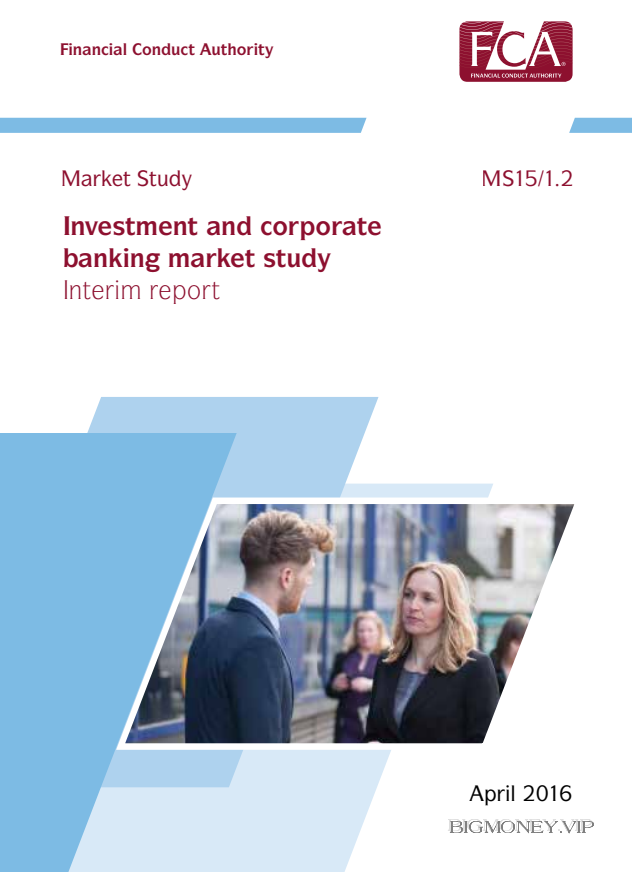Market Study Investment and corporate banking market study Interim report

1.
Executive summary
Chapter summary
Primary markets play a vital role in the economy matching investors with corporates
and public bodies who need to raise finance. The UK is a leader in equity capital
markets (ECM), debt capital markets (DCM) and merger and acquisition (M&A)
activity. These primary market activities comprise around a quarter of revenues
earned by universal banks, and in 2014 total gross fees in primary markets generated
by investment banks’ UK operations amounted to approximately $17bn.
During our Wholesale sector competition review last year, stakeholders raised a
number of concerns in relation to primary markets. Many of these concerns centred
on cross-subsidies in the universal banking model between corporate banking and
investment banking as well as specific market practices such as syndication and
reciprocity. While many clients feel well served by primary market services, we found
some of the concerns were borne out in the evidence we have collected and we are
inviting views on potential measures to address these.
Interim findings
Universal banking and cross-subsidies
There is a wide range of banks and advisers active in primary market services. There
are often between 20 and 40 banks active in any particular sector and for different
types of client – sovereigns, supra-nationals and agencies (SSAs), financial institutions
and corporate clients.
Lending and corporate broking are typically supplied at a low rate of return or below
cost in exchange for a flow of transactional business, which is typically more lucrative.
Nearly three-quarters of DCM primary market roles are awarded to a bank with whom
the client has an existing corporate banking or lending relationship, however the link
is significantly weaker for initial public offerings (IPOs).
From a client perspective, this model seems to work well for large corporate clients,
who typically have a wide range of lending banks or joint corporate brokers that
compete against each other for transactional mandates. However, medium-sized
corporate clients (those of a size equivalent to the UK FTSE 250) and small corporate
clients (those of a size equivalent to the UK FTSE Small Cap and AIM), who typically
have fewer banking relationships, may feel the need to “reward” a lending bank
or corporate broker with transactional business even when that bank would not
otherwise have won a mandate. Pressure to award transactional business to a lending
bank or corporate broker can be exacerbated by the widespread use of contractual
clauses in client engagement letters restricting future choice of supplier.
The provision of cheap lending and corporate broking makes it harder for those
banks providing only transactional services to compete. While boutique advisers have
successfully entered in M&A, entry and expansion as book-runners in ECM and DCM
has been mainly by banks that also lend. We have seen little evidence of emerging
technology-driven disruption or disintermediation of primary market activities.
Other market practices
We looked at a range of market practices to assess whether they restrict or distort
competition and adversely affect outcomes for clients. We found the following
concerns:
• The ‘blackout’ period in the UK IPO process between publication of research by
syndicate banks and the circulation of the ‘pathfinder’ prospectus means that the
pathfinder and approved prospectuses, both key sources of information, are made
available too late in the process to be used by buy-side investors, non-syndicate
banks’ analysts and independent research providers. When coupled with a lack of
access to the issuer’s management for non-syndicate bank analysts, this reduces
the diversity and independence of information available to investors.
• Allocations of shares in IPOs are skewed towards buy-side investors from whom
banks derive greater revenues from other business lines (e.g. trading commission).
Although these investors may be long-term holders and of benefit to issuing
clients, there is also a risk that allocations do not align with issuing clients’ best
interests and may shut out other investors.
• League tables that rank investment banks can be misleading because some banks
carry out loss-making transactions purely to generate a higher position in league
tables. Furthermore, banks routinely present league tables to clients in a way that
inflates their own position. Many clients are aware of these practices; nonetheless
we believe they impede effective client choice.
We also analysed the practices of reciprocity and syndication. We are not minded
to pursue these issues further at this stage although we may revisit reciprocity if its
prevalence or impact develops significantly:
• Reciprocity is a practice whereby a bank issuing its own financing awards mandates
to another bank partly based on how much business it will receive in return. It is
currently most prevalent in the bank financing market, particularly covered bonds,
but at present this practice does not appear to be excluding other banks from
competing.
• The size and composition of ECM and DCM syndicates are controlled by clients.
Larger syndicates are not associated with higher fees, and they can broaden clients’
relationship options and provide a route for smaller banks to enter and expand.
Market Study Investment and corporate banking market study Interim report




